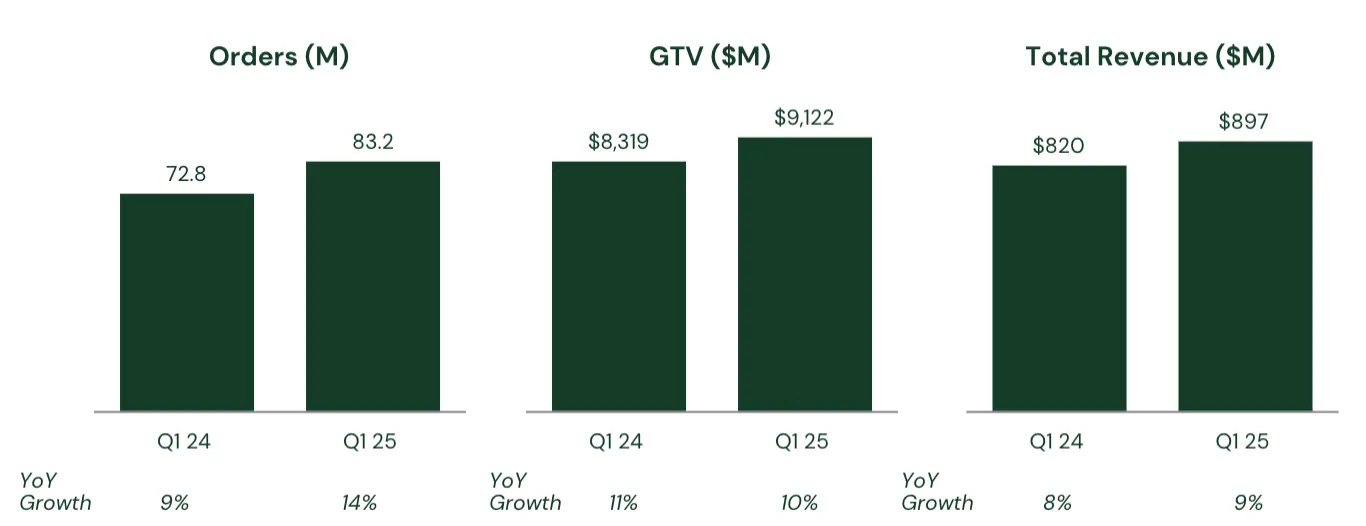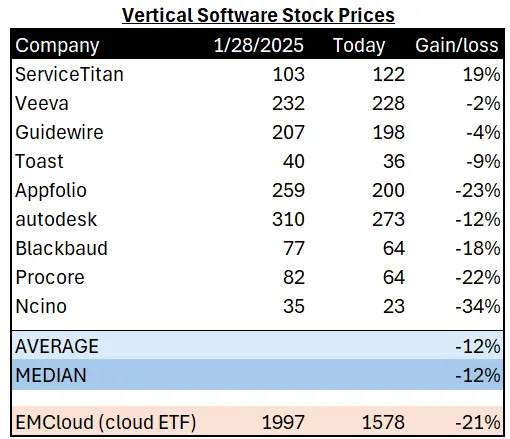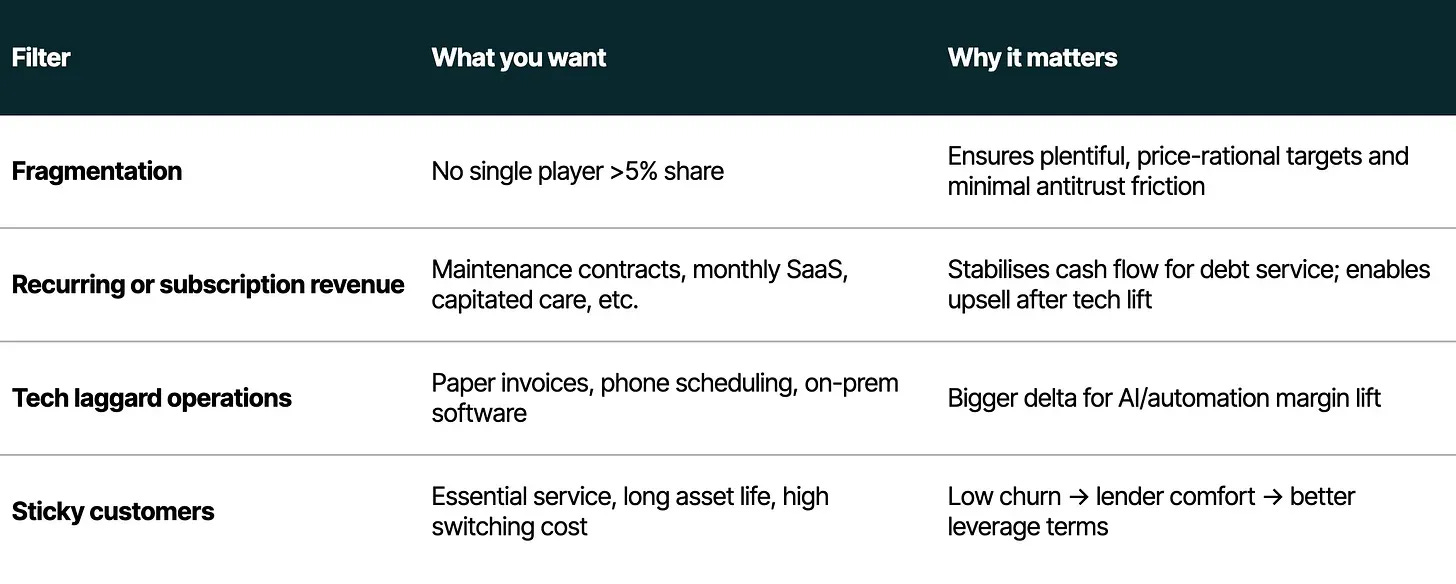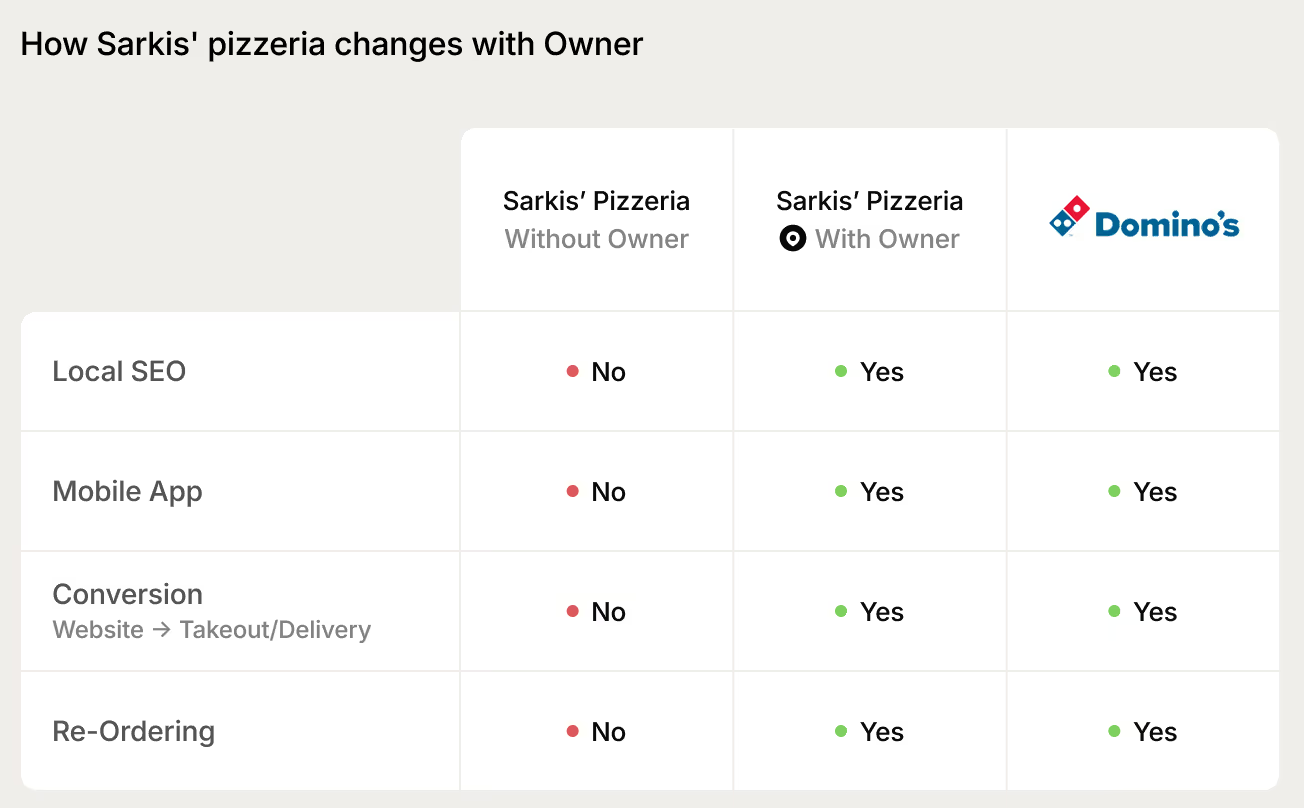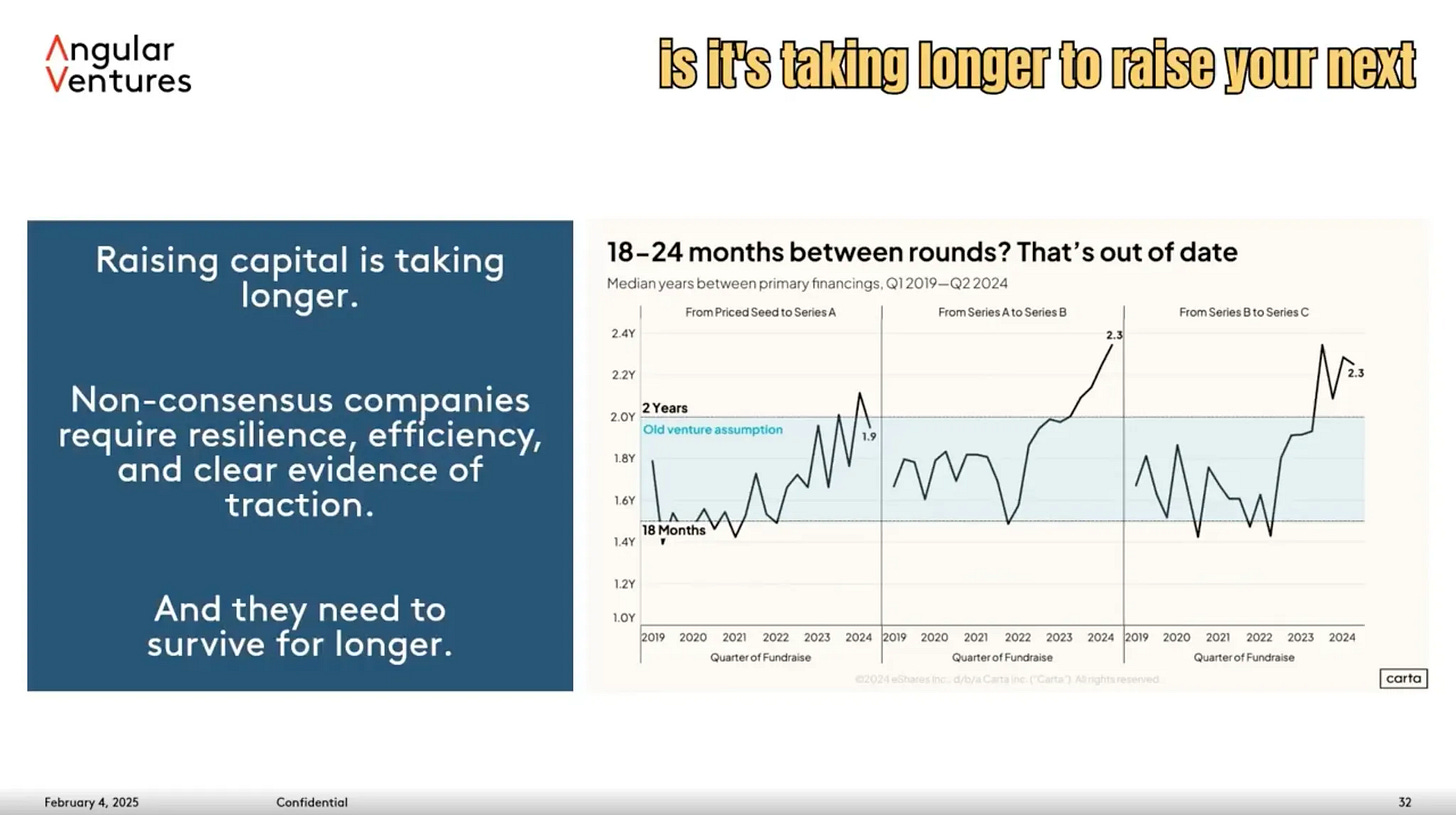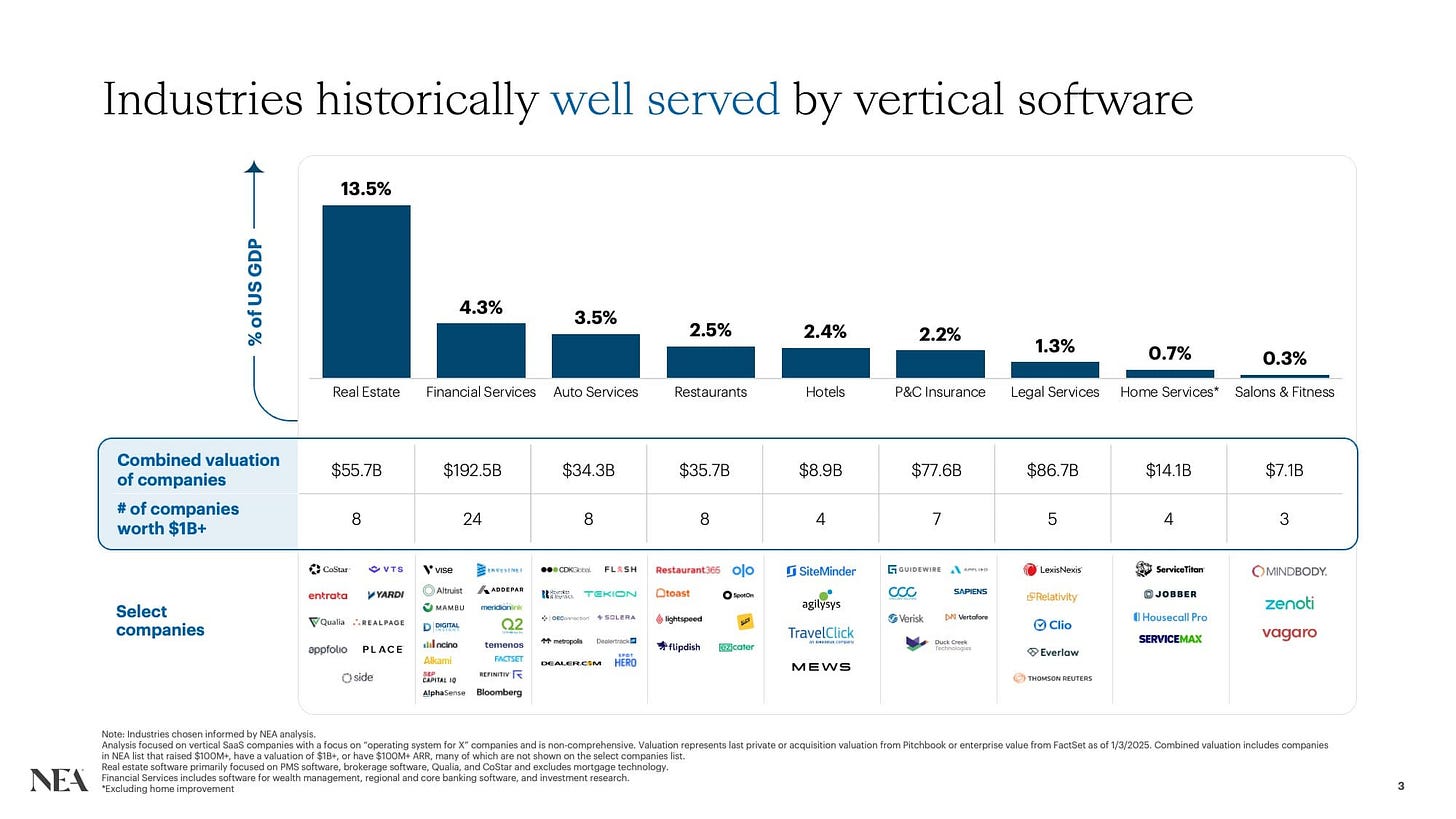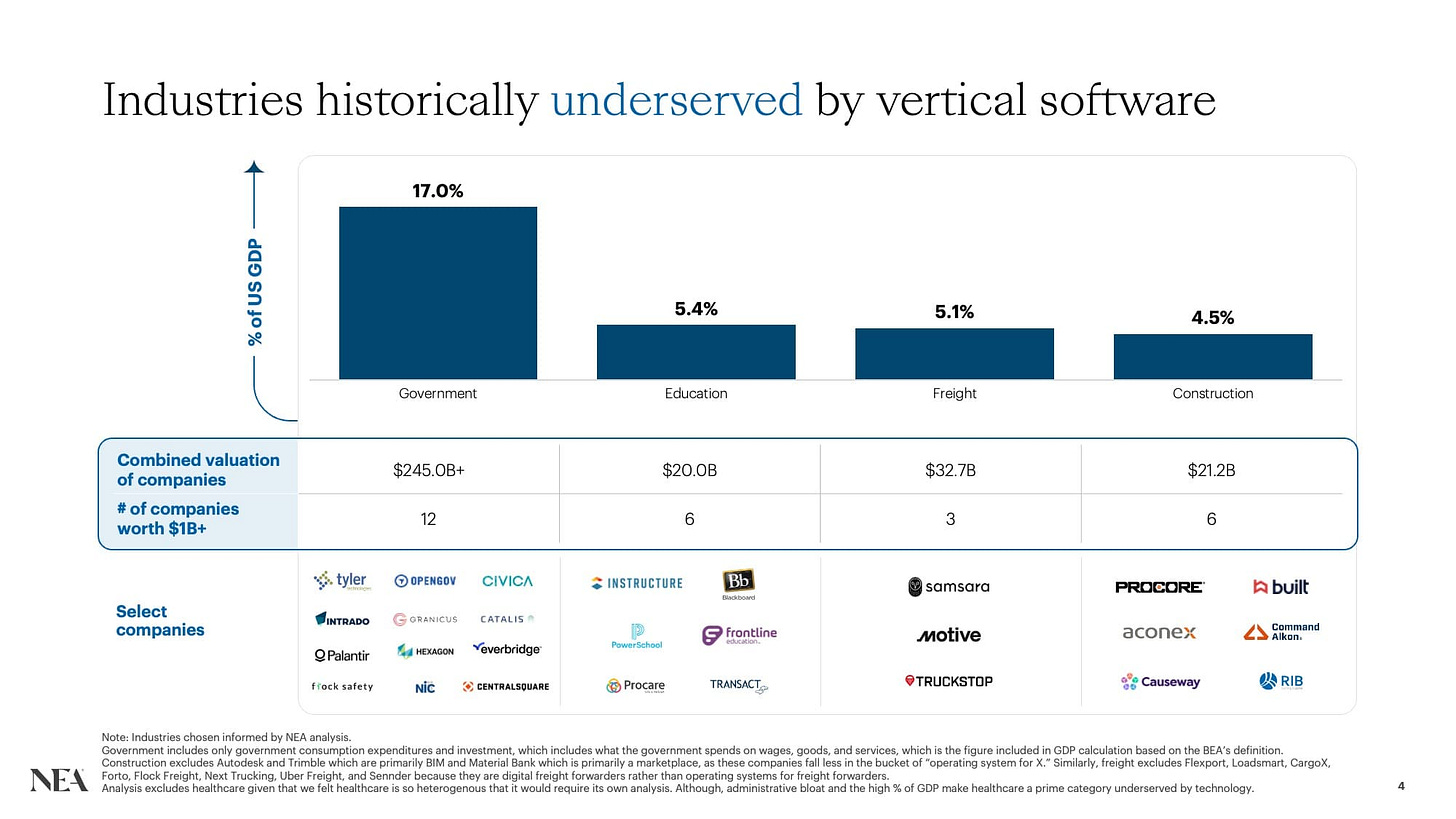Hi, it’s Alex from 20VC. I’m investing in seed & series A European vertical solutions (vSol) which are industry specific solutions aiming to become industry OS and combining dynamics from SaaS, marketplaces and fintechs. Overlooked is a weekly newsletter about venture capital and vSol. Today, I’m sharing the most insightful tech news of May.
Thursday, May 1st: In 2024, Doctolib reached €348m in ARR growing 22.5% YoY and with a 40% CAGR over the past 5 years. Doctolib started as a booking management system before becoming an all-in-one platform for doctors. It burned €54m in 2024 compared with €87m in 2023. It means that Doctolib is below the rule of 40% reaching only 7% when you add its ARR growth to its profitability margin. It has 80m patients and 400k healthcare professionals implying a €870 ACV. Doctolib makes 81% of its revenues in France, 17% in Germany and 2.6% in Italy. The company is doubling down on AI with 115-120 people working exclusively on AI and with a plan to launch c.10 AI products in 2025 including an AI receptionist and automatic generation of medical letters. - Les Echos
Friday, May 2nd: In 2024, French meal voucher startup Swile reached €204m in sales growing 25% YoY and generated €36m in EBITDA implying that the company is above the rule of 40 (42.6% when you add its growth rate to its EBITDA margin). It won large contracts in the public sector with France Travail, SNCF and the Ministry of the Economy. In 2025, Swile wants to double down on its geographical expansion in Brazil and product diversification (especially in travel management). - Loïc Soubeyrand, Les Echos
Saturday, May 3rd: Harry recorded another great show on recent venture news with Rory O’Driscoll at Scale and Jason Lemkin at SaaStr. - 20VC
The size of a company's market cap dictates the scale of M&A deals they can pursue. A deal representing 10% of market cap is considered a "bet the farm" deal led by the CEO (e.g. Adobe trying to buy Figma, Facebook buying Instagram or WhatsApp), while 1% is seen as an "SVP deal" (e.g. OpenAI buying Windsurf at 1% of its market cap).
Multi-stage venture firms are increasingly pushing out traditional seed funds. Their efficiency, lower cost of capital, and ability to double down on successful early investments make them formidable competitors at the seed stage.
The sustainability and persistence of high growth rates are crucial to justifying high valuations. A 100x multiple is only viable if the company can maintain a high growth trajectory to de-risk the multiple before potential public market intersection.
Paying up for growth rates at high multiples that ultimately don't materialize, as seen in 2021, leads to significant problems. "I think what happened in 2021 is that a lot of people paid up for growth rates at 100x and then didn't get the growth. This is a fiasco".
Due to the pressure on cash flows, endowments are forced to prioritise liquid assets over illiquid ones. As a consequence, LPs are prioritizing maintaining relationships with established, top-tier firms, which can make it challenging for them to commit to new funds.
For VC firms, the priority should be executing their core strategy well rather than being distracted by deals outside their defined sweet spot. “I'm far more worried about missing a 5-10x deal that was in the sweet spot than missing the Hail Mary that was outside my sweet spot".
The job of a venture investor is to identify unique insights about the future that others miss and find a way to monetize those bets. "Once you discover a unique, enduring insight, your job is to find a way to monetize it.”
Despite the AI wave, vertical SaaS is still considered underinvested. While AI will lead to more competitors, many categories will not see the same level of saturation as horizontal tools.
Sunday, May 4th: Instacart published its Q1-2025’s results. - Instacart, Bloomberg
“In Q1, we grew orders by 14% YoY to 83.2m and drove GTV up 10% YoY to $9,122m.”
“In Q1, we also delivered net income of $106m and Adjusted EBITDA of $244m, showing that we can aggressively reinvest in innovation while continuing to deliver strong profitability.”
“We’re executing on this through relentless product innovation across the four dimensions consumers care about most: convenience, affordability, quality, and selection.”
“We also continue to expand our ecosystem and recently added Uber Eats’ U.S. grocery and retail marketplace as a new Carrot Ads partner. Uber Advertising chose us because of the superior performance of our ad tech and the scale of our demand from over 7,000 active brand partners. With Carrot Ads powering the retail media networks for over 220 retail sites, including competing marketplaces, it’s a strong signal that what we’ve built is truly best-in-class.”
“Instacart introduced Store View, a new inventory intelligence technology designed to improve overall order quality by using AI to analyze video footage and enhance our real-time understanding of what’s on store shelves.”
“Instacart said customer engagement ticked up in part because it lowered the minimum basket size for free delivery to $10 from $35 for paid subscribers. This encouraged more mid-week grocery shopping, the company said in the letter.”
“Instacart has invested into higher-margin areas to drive growth, including advertising and e-commerce software for grocery stores. Those businesses now bring in about 28% of the company’s revenue.”
Instacart also acquired Wynshop which is a provider of e-commerce solutions for grocers & retailers covering digital storefront, mobile shopping, advanced search, loyalty management and AI personalisation.
Monday, May 5th: To remain globally relevant, Europe must urgently pursue reforms: (i) increase military spending, (ii) deepen economic integration within the EU and with the UK, (iii) streamline regulations, and (iv) address its demographic crisis. - The Economist
“The European Union at the continent’s heart oddly cherishes the insouciant belief it can change only if forced to do so by crisis.”
“Amid the tumult that reigns in the world, Europe must embrace change.”
“Having long relied on China’s market for growth, Russian gas to fuel its industry and American military heft for security, the EU has been rocked by three years of war in Ukraine and three months of Donald Trump’s agressive transactionalism in America. Amid the tumult that reigns in the world, Europe must embrace change.”
“Brexit is now held up as a cautionary tale, not a model to emulate. Still, despite endless talk of “resets” in the relationship, bashing les rosbifs remains the order of the day. This is a policy extravagance. Britain has military, geopolitical and industrial heft that can amplify Europe’s sway in Ukraine.”
“Europe is a shrinking force in the global economy. It is a luxury to pretend otherwise.”
“If the EU cannot trade with America as freely, its 27 member countries could instead do more business with each other. Yet administrative barriers to trading services between EU countries are equivalent to a 110% tariff, according to the IMF.”
“Europe’s most hedonistic habit in recent decades has been to scrimp on defence. Gorging on the “peace dividend” that followed the end of the cold war meant more money for social spending.”
Tuesday, May 6th: Kyle Chan wrote a great post on Huawei’s role in the Chinese tech industry. - High Capacity
“Huawei stands at the heart of China’s technological ambitions. Founded in 1987 as a small supplier of telephone switches, Huawei has transformed into a globe-spanning giant, making over $100 billion a year selling everything from 5G infrastructure and video conferencing equipment to smartphones and smart watches.”
“Huawei’s story is central to the broader history of China’s industrial policy, which can be viewed as a series of frantic races to patch up the country’s technological vulnerabilities and reduce its reliance on foreign powers.”
“To acquire foreign technology and develop its own telecom industry, China used the promise of its vast and growing domestic market to actively bring in foreign equipment makers and have them form joint ventures with Chinese firms.”
“China had deliberately created space for multiple strong competitors to emerge so that the industry overall would continue to make progress. Over time, China would use this strategy of “managed competition” in a range of industries, from the automotive sector to high-speed rail. Rather than creating a single state monopoly or simply leaving things to market forces, China would try to get the best of both worlds by honing a few key industry players and letting them compete in a supervised setting.”
“Huawei also benefited from international cooperation. The company set up more than 20 R&D centers across the U.S. and Europe. It sponsored research collaborations with universities around the world. And it partnered with leading foreign companies, such as Nortel, Nokia, and Motorola. At the same time, Huawei was frequently accused of stealing intellectual property from competitors.”
“By 2015, Huawei supplied half of Europe’s 4G equipment. By 2020, it had become the world’s bestselling smartphone maker. Huawei and China had finally won the international trust and respect they had long sought.”
“On May 15, 2019, Huawei received news that every prominent Chinese tech company has come to dread: it was placed on the U.S. Department of Commerce’s infamous “Entity List” by the first Trump administration. This blacklisting dealt a devastating blow to Huawei by cutting it off from the American chips and software that powered its smartphones, including Google’s Android operating system. Ren Zhengfei made the difficult decision to sell off Huawei’s popular Honor smartphone unit in 2020 for $15 billion. Huawei’s revenue the next year fell by 27 percent.”
“Under pressure on multiple fronts, Ren Zhengfei put Huawei into war mode. His firm had spent billions of dollars stockpiling enough semiconductor chips to last for two years; HiSilicon, Huawei’s chip design unit, had been working for years to develop “spare tires” in case Huawei lost access to foreign chips. And now Huawei threw the full weight of its formidable R&D capabilities into developing its own chips and operating system. What had previously been a backup plan transformed overnight into Huawei’s top priority.”
“Huawei has been tasked with leading a “Manhattan Project” to make China’s entire semiconductor supply chain self-sufficient.”
“Huawei’s AI chips are now being used widely by Chinese AI companies, providing an alternative to export-controlled GPUs from Nvidia.”
"Huawei’s unexpected advances combined with DeepSeek’s stunning breakthroughs in AI have raised questions about whether restricting China’s access to technology may have ultimately backfired. By forcing China to become self-reliant, the question is whether these policies had in fact accelerated China’s technological development rather than hindered it.”
Wednesday, May 7th: CVC acquired a minority stake in Turkey-based Dream Games, valuing the mobile game developer at a $4-5bn valuation. The deal includes over $2bn in equity from CVC and debt from Blackstone, enabling Dream’s early VC backers—Balderton, Makers Fund, Index, and IVP—to fully exit. Dream’s five co-founders will remain majority shareholders. Known for hit titles like Royal Match and Royal Kingdom, Dream Games has thrived by focusing on quality, character development, and ad-free gameplay. In 2024, it generated $2.5bn in revenues and posted a $500m EBITDA (20% margin). - FT, Rob Moffat, CVC
“Dream Games was founded by former executives at Peak Games, another Turkish mobile developer that was acquired in 2020 by US rival Zynga, and had previously been valued at $2.75bn in early 2022.”
“The transaction will provide liquidity to Dream Games' initial venture capital partners who will exit after over five years.”
Thursday, May 8th: Year to date, vertical software companies have shown greater resilience than the broader software sector. - OnlyCFO
“Public cloud stocks are down 21% since the end of January of this year (similar to the rest of the market). But public vertical software companies have “only” declined by 12% since January— showing higher resilience than their horizontal software friends.”
“For 90%+ of companies starting today I think you either need to take a “compound software” approach or vertical software (which should also be a “compound software”) to succeed. Most companies start as a point solution but to be successful today requires an acceleration to multi-product that takes a compound software approach.”
Friday, May 9th: Jonathan Feilberg wrote about venture roll-ups which are a hybrid between VC and private equity, where tech-first firms scale by acquiring profitable SMBs at low multiples, applying software or AI to enhance margins, and targeting high returns. - Jonathan Feilberg
“Venture rollups are tech-first companies that scale primarily by buying profitable businesses, then inject proprietary software or AI agents to raise margins and growth. They finance the spree with venture equity first, moderate leverage second, and target 10-20x returns.”
“Venture rollups mix high-multiple equity with low-multiple acquisitions, often supplemented by debt, to arbitrage value. This capital strategy aims to deliver private equity levels of risk with a venture-like upside potential.”
“Buying the service provider - an accounting firm, call-center outsourcer, or HVAC contractor - and installing AI agents can be cheaper and faster than selling those agents one license at a time. In essence, tech can now transform low-multiple service cash flows into high-multiple software cash flows.”
Saturday, May 10th: Sabre is selling its hospitality solutions business to private equity firm TPG for $1.1bn in an effort to reduce its debt and to refocus around its core business - airline technology. - Skift, TPG, Reuters
“The SaaS based platform serves as an integrated system of record for reservation and guest information, enabling hoteliers to operate with greater accuracy and efficiency. Hospitality Solutions is distinct from Sabre's hotel B2B distribution business, which remains a strategic area of investment for Sabre.”
“SynXis is a cloud-based platform designed to streamline hotel operations and maximize revenue. At its core is the SynXis Central Reservation System (CRS), which enables hotels to manage availability, rates, and inventory across multiple channels—including OTAs, GDSs, direct booking engines, and call centers—from a single interface. The platform also includes the SynXis Booking Engine, offering customizable, mobile-friendly direct booking experiences with integrated upselling tools. Additional modules like SynXis Pay simplify global payment processing, while SynXis Insights provides real-time analytics to support data-driven decisions.” It serves 40k hotels accounting for 5m rooms in 160 countries. It processes $50bn in annual room sales.
Sunday, May 11th: DoorDash acquired SevenRooms, a leading vertical SaaS in hospitality, for c.$1.2bn in cash. - DoorDash, SevenRooms, Bloomberg
SevenRooms was founded in 2011. It does $150m in ARR from 13k locations ($11k ACV). SevenRooms specialises in customer relationship management (CRM), marketing, reservations, and guest experience tools for restaurants, hotels, and hospitality businesses.
DoorDash is moving from its core food delivery business into a full-stack local commerce and hospitality tech provider.
SevenRooms works with luxury brands like Marriott, MGM Resorts, and Wolfgang Puck. This acquisition gives DoorDash access to high-margin segments such as fine dining and luxury hospitality, areas where competitors have limited presence.
“The company’s buying spree highlights DoorDash’s ambitions outside of the US, where it already commands about two-thirds of the food-delivery market.”
“DoorDash’s acquisition of SevenRooms will give it a reservation platform and customer-management tool similar to OpenTable or Resy that works with more than 13,000 restaurant groups.”
“In 2022, DoorDash worked with SevenRooms to pilot restaurant reservations within the DoorDash app in New York, Los Angeles and Chicago. In addition to restaurant delivery, DoorDash also offers white-label services to build ordering interfaces for restaurants’ websites and phone answering systems.”
Monday, May 12th: Stripe announced 60 new product launches and major upgrades during Stripe Sessions 2025 including: (i) orchestration to manage multiple payment processors directly within Stripe, (ii) optimised checkout with AI models to personalize checkout in real time using over 100 signals, (iii) stablecoin financial accounts to store and transfer stablecoins reducing costs and delays for cross-border payments, (iv) an AI foundation model dedicated to payments enabling new use cases like automated dispute handling or benchmarking to compare performance against similar businesses, (v) Stripe Profiles as a public identity for businesses on the Stripe network to streamline invoicing and payments between businesses and (vi) managed payments giving merchants everything they need to enter new markets (e.g. taking care of global taxes, fraud prevention, dispute management, fulfillment, etc.). - Stripe 1, Stripe 2, Techcrunch
“Stripe Connect now helps more than 15,000 SaaS platforms—supporting more than 10 million businesses—embed payments and financial services directly into their platform.”
In the US, 2 million businesses run on Stripe which is 6% of US businesses. 50% of F100, 80% of Forbes Cloud 100 and 78% of Forbes AI 50 are building on Stripe.
“When new technologies collide with a turbulent economy, the technology tends to win.”
“We compared AI retention rates to SaaS retention rates. Individual AI companies see a lower retention rate than their SaaS counterparts but customers are typically turning to other AI tools. At the industry level the lines flip. AI overall has higher retention than SaaS.”
“60% of small businesses in America use one SaaS platform or another to start and manage their business.” “The growth in small business creation has happened contemporaneously with the growth of SaaS platforms serving them.”
Tuesday, May. 13th: Figma announced multiple product updates during Figma Config 2025 including (i) Figma Sites enabling users to design, customize, and publish fully responsive websites directly from Figma, (ii) Figma Make leveraging AI to transform designs into interactive prototypes or even fully functional apps, games, and animations, (iii) Figma Buzz for marketing teams and non-designers to bulk-generate branded content (text, images, variables) from CSV files without editing the core design files and (iv) Figma Draw which is a next-generation drawing suite. - Figma, Verge
“Figma is expanding its creative software ecosystem to allow product designers to complete entire projects without jumping to third-party apps. Four new products for website building, AI coding, branded marketing, and digital illustration were introduced at Figma’s Config event today, aiming to fill in any gaps holding Figma back from being an all-in-one platform that supports the entire product design lifecycle.”
“The line between design and production has always been artificial—a boundary created by tools, not by the requirements of the creative process itself. This is where we see a huge opportunity for Figma Make, our new prompt-to-code capability that lets you take an existing design and prompt your way to a fully coded prototype.”
“We want Figma to be a space where you can prototype, fine-tune, iterate, and ideate—all the way to the finish line—all in one place.”
Wednesday, May 14th: In 2024, Vinted reached €813m in revenues (growing 36% YoY) with €159m in EBITDA (20% margin) and €77m in net profit (9% margin). It expanded into new geographies including Croatia, Greece and Ireland. It also doubled down on new categories like electronics and luxury fashion. - Vinted
“Vinted Go continued successfully scaling its logistics operations to offer low-cost, convenient shipping to Vinted members via locker and pick-up-drop-off networks.”
“Vinted continued investing into Vinted Pay, which launched its first services in Lithuania. Vinted Pay’s aim is to make transactions on Vinted easier, driving down cost and further strengthening the Vinted ecosystem.”
“This month Vinted launches a dedicated investment arm, Vinted Ventures. Vinted Ventures is focused on investing in the next generation of founders and startups in the re-commerce value chain.”
Thursday, May 15th: Jack Altman interviewed Josh Kopelman who cofounded First Round. - Jack Altman
Since 2004, the number of active VC funds and check writers has dramatically increased. There are now over 10,000 funds and probably over 20,000 active check writers, compared to fewer than 850 funds and 1,000-2,000 people back then.
The "Blackstone-ification" of venture. There's a growing trend towards a scale-driven model in venture, similar to what Blackstone has done in private equity, focusing on total cash returns (decent multiple on large Assets Under Management) rather than traditional alpha (high IRR).
"Instead of targeting a 25% or a 4x, new LPs coming to the venture asset class might be looking at a 2x or a 12% IRR. When you bring new investors with different capital returns expectations it could be really transformational for the industry.”
In the competitive private market, relevancy (being active, connected, and visible) is crucial for gaining access to deals. This creates a "Matthew effect" or "hot hand" phenomenon where activity begets activity, giving larger, more active funds an advantage in deal flow, regardless of past investment performance in some periods.
“In venture, we make our money in the extreme greed cycle. For the last 40 years, all of those returns don't come from equilibrium but from irrational disequilibrium in the market.”
Friday, May 16th: Owner raised a $120m series C round led by Meritech and Headline at a $1bn valuation. It offers AI-powered website building and automated marketing tools to support 10k restaurants in competing against larger corporations. - Meritech, Bloomberg, Owner
“Owner is building Shopify for local business owners, starting with restaurant owners. The fate of every business is being determined by its online presence.”
“Owner is an opinionated product that rejects customization. It delivers the outcome of profitable sales growth, rather than being a tool in the workflow.”
“Owner is stacked with founder DNA: more than 25 team members are former founders! Many have raised millions, led startups as CEOs, and are now individual contributors at Owner.”
“Owner is the full digital stack for restaurants. It combines everything they need to succeed – the website, mobile app, online ordering system, loyalty program, marketing automation engine, and more. All in one place, with one consistent data model. Gone are the days where restaurant owners manage 10+ disparate, generic tools that require technical expertise to optimize.”
“Today, Owner uses AI to optimize SEO best practices, automatically generate high-intent web pages, and increase checkout conversion. In 2025, they will leverage the massive amount of data they have amassed to release AI executives. Think a digital CMO recommending and executing a marketing campaign in advance of Thanksgiving, a CTO suggesting website updates after Google changes an algorithm, or a CFO informing you that a dish is dragging down your bottom line.”
Saturday, May 17th: Bpifrance invested several tens of millions of euros in Septeo at a €3-4bn valuation. It’s a leading French software group majority owned by Hg Capital and specialised in legaltech, proptech, HR, and hospitality solutions. In 2024, Septeo reached €420m in revenues with 3.1k employees. It plans to spend €60m per year in AI. - Septeo, Maddyness
Septeo has allocated €60m to AI development, training large language models on client data to automate tasks such as drafting legal documents.
Sunday, May 18th: Notion, Otter.ai, and Granola will increasingly compete with GSuite, Zoom, Slack, and Teams to become the enterprise’s unified layer for documents, meetings, search, and social collaboration. - Gokul Rjaram
“Enterprise content has traditionally been stored in documents. However, a new valuable repository is emerging: AI-transcribed meeting notes. Docs are static, structured and factual (and searchable!). They are designed to be referenced, shared, and reused (e.g., strategy docs, product specs, OKRs), reflect agreed-upon facts or strategies, and are easier to disseminate across the organization. On the other hand, meeting notes are dynamic, real-time and opinionated (and queryable!). They capture decision-making processes, strategy shifts, tone, and contextual nuance, and include brainstorming, feedback, concerns, and off-the-record info that never makes it to formal documents. Meeting notes and Docs thus perfectly complement each other. Together, they constitute the repository of enterprise wisdom.”
Monday, May 19th: David Clark looked at the evolution of VC-backed exits from 2005 to today showing that the largest exits are getting larger overtime. - David Clark
“The value of the top 1% exits essentially double every 5 years. If this trend continues then the top 1% exit for funds investing today would be $40bn+ (8-10 year holding period).”
Tuesday, May 20th: Airbnb relaunched Airbnb Experiences. - Airbnb, Thomas Reiner
“A great business could get to $1 billion of revenue, and you should be able to expect one or a couple of businesses to launch every single year for the next five years.”
“Airbnb launched new experiences (tours, attractions, etc) as well as services (think massages, in-home chefs, etc). This has been a long time coming as the original experiences offering wasn’t up to snuff and never really hit escape velocity.”
“The big question is whether this will a) see widespread consumer adoption, and b) what it’ll do from a competitive perspective to peers like Viator, Klook and GetYourGuide.”
“Despite the industry being large (over $265B in 2024 estimated from industry sources), the big online players just aren’t that penetrated into the market.”
“The normal booking and planning flow for a vacation is as follows: 1) find a flight two to three months out, 2) book a hotel or an Airbnb shortly after the flight but usually not at the same time, 3) book your rental car or transportation once you know where you’re going and how to get there, 4) book your tours and experiences a couple weeks beforehand. The dislocation of time means in order for Airbnb or Booking to bring you back for an experience booking they have to re-capture your attention which is difficult or expensive or both.”
“The next 6-12mo will unlikely see much direct competitive overlap between Airbnb and the other big players as they’re approaching the problem of online penetration from a different tack.”
Wednesday, May 21st: Walmart has become a tech-savvy retailer leveraging its vast store network for e-commerce, investing in AI to improving ads & logistics and operating a successful membership program called Walmart+ generating $3.8bn in annual revenues. - The Economist
“The newest Walmart warehouses are vast hangars filled with conveyor belts, computer screens and robotic arms that silently pick and pack products. AI tools ensure pallets are loaded onto trucks in such a way that they can be unloaded in stores with ease: fragile items at the top, urgent products at the front and things that go in the same aisle together.”
“With $680bn in revenue last year (inc. $100bn from e-commerce) and 2.1m workers, it is the largest company in the world on both measures. In America it takes in a tenth of all retail spending, excluding cars, and a quarter of the outlay on groceries.”
“In the past year its market capitalisation has soared by over 50%, to more than $750bn. At nearly 40 times earnings, it is now valued at a higher multiple than Alphabet, Amazon, Apple, Meta or Microsoft.”
“Walmart’s strength has always been its physical footprint. Walmart has some 5,000 stores across America; 90% of Americans live within ten miles (16km) of one. Mr McMillon has put that infrastructure to work to boost online sales.”
“With a third-party marketplace much like Amazon’s, Walmart has expanded its online range to hundreds of millions of products.”
“Walmart’s American e-commerce unit made over $100bn in sales last year, according to eMarketer, a research firm. Although it remains a distant second to Amazon, with $480bn of e-commerce sales in America in 2024, Walmart is gaining ground: its online sales are growing at around 20% a year, twice as fast as its rival’s. In the tricky category of grocery deliveries—which require a temperature-controlled supply chain and speedy distribution—it already has the lead.”
“The retailer is now training up Sparky, an AI assistant that helps customers find products, and Wally, which helps its merchandising teams choose items to sell.”
Thursday, May 22nd: The Economist ranked countries’ military budget using three methodologies: raw dollar totals, share of GDP and military purchasing-power parity. - The Economist
“Regardless of which measure you consult, the past year has seen a sharp increase in global spending on defence. Budgets totalled $2.7trn in 2024—up by 9.4% from 2023, the biggest jump since at least 1988. Military outlays now account for 2.5% of countries’ GDP on average, and 7.1% of government budgets.”
“Behind America, China, Russia and India are the next biggest military spenders.”
“Ukraine tops our ranking for spending as a share of GDP. By this measure, Ukraine spends vastly more on defence than any other country, at 34.5%. Last year, the country spent $65bn in raw dollar terms, or $199bn at military PPP. In addition, the country gets military aid from its allies. In 2024 $45.3bn of such assistance was announced, according to the Kiel Institute, a German think-tank.”
“Excluding America, NATO members have boosted spending by 24% over the past two years at constant prices.”
Friday, May 23rd: Gil Dibner publicly shared an excerpt from Angular’s Annual General Meeting with its LPs, offering insights into the current state of the venture market. - Angular
“While AI-focused companies, hyper-growth firms, and experienced second-time founders continue to attract substantial capital and high valuations, conditions are notably challenging for others.””
“We see five distinct swimlanes emerging in VC, which is completely reshuffling the industry. VC is a totally different game today than it was even five years ago.”
“Fundraising processes have become considerably longer, with the average time from Seed to Series A now exceeding two years.”
Saturday, May 24th: Orlando Bravo warns that retail investors risk inheriting unsellable private equity assets as buyout firms struggle to exit pandemic-era deals. - FT
“The private equity industry has been struggling to sell assets that it bought at high prices during the rock-bottom interest rate years of the pandemic. Buyout shops have less money to return to their traditional institutional backers as a result and are less able to raise money from those backers for their new funds. An influx of capital from retail investors into so-called evergreen funds, which have no end date and allow cash to be deposited and withdrawn at regular intervals, has partially helped fill the fundraising gap.”
“The retail investors might not be as sophisticated. There might be more risk of them not understanding what they’re involved in and this could create all sorts of problems.”
Sunday, May 25th: NEA wrote about the impact of AI on vertical software companies. - NEA
“In the cloud era, we witnessed large vertical software winners such as Procore ($11B), Toast ($21B), and ServiceTitan ($9B). The winners of this first wave followed a common pattern: (i) system of records automating & centralizing customer data, (ii) payments & billing streamlining financial workflows & business intelligence, (iii) marketplace bringing ecosystem of industry participants onto one platform.” The AI revolution opens up a fourth layer with agentic systems i.e. “AI actions significantly automating remaining labor-heavy workflows”.
“In a world where software takes actions on behalf of users, the traditional workflow advantage of systems of record diminishes. If AI agents process data before it ever reaches these systems (and generate new data abstracted from the systems of record), the incumbents risk losing their advantage tied to data ownership and the resulting switching costs.”
“In the future, the control point may shift to the agentic layer, potentially reducing the importance of existing systems of record and redefining the competitive landscape.”
3 wedges for vertical AI companies: (i) voice agents, (ii) semantic search & document analysis, (iii) unstructured data processing & content generation.
“Companies like Avoca, Revin, and Drillbit use voice agents to handle inbound and outbound sales, integrating with incumbents like ServiceTitan. For new jobs that come over the phone, data for new jobs first flows into the contact center before it ever reaches ServiceTitan for dispatch / CRM.”
“In industries that have already produced $10B+ winners, the potential to build a large company is evident; the challenge lies in whether AI-native companies can outperform established incumbents.”
Monday, May 26th: The New York Times wrote on the European tech ecosystem. - NYT
“Europe lacks any homegrown alternatives to the likes of Google, Amazon or Meta. Apple’s market value is bigger than the entire German stock market. The continent’s inability to create more big technology firms is seen as one of its biggest challenges and is a major reason why its economies are stagnating.”
“Investors and entrepreneurs say obstacles to tech growth are deeply entrenched: a timid and risk-averse business culture, strict labor laws, suffocating regulations, a smaller pool of venture capital and lackluster economic and demographic growth.”
“Only four of the world’s top 50 tech companies are European, despite Europe having a larger population and similar education levels to the U.S. and accounting for 21% of global economic output.”
“Europe is dominated by old-school industries like autos and banks that extracted productivity gains long ago. The typical company in the top 10 publicly traded U.S. firms was founded in 1985, while in Europe, it was in 1911, according to the International Monetary Fund.”
“A big reason why Europe is now behind can be summed up as a lack of speed. Entrepreneurs complain that everything takes longer in Europe: raising money, complying with local regulations, and hiring and firing workers.”
“Scaling up quickly in Europe is hard. The U.S. is a large integrated market, while Europe has dozens of countries with their own language, laws and taxes. Labor laws slow down worker mobility by making it harder to hire and fire workers. Until the past year or two, stock options in most European nations were little used because they were taxed as income before they vested. Taxes are higher, and regulations designed to corral big business become a costly and time-consuming headache for startups.”
Tuesday, May 27th: I listened to a Business Breakdown episode on Twilio with Ro Nagpal who is investor at Holocene Advisors. - Business Breakdown
Twilio’s vision is to enable developers to access the world's communication infrastructure through APIs.
“Twilio is software that enables companies to communicate with their customers through SMS, through voice, through video or chat.”
“Prior to Twilio, if you wanted to do this, you would need to go out and hire 10 engineers with a decade of telecom experience that were all super expensive and you'd need to have them sit in your building and spend 12 months making all the connections to Verizon and AT&T to enable you to do this.”
“When he was younger, Jeff Lawson was a product manager at AWS. I think he saw the birth of AWS and the idea that you could take really complicated infrastructure and turn it into code.”
“The most common unit is a text message. And that costs 0.7 cents. Twilio has to route that message across AT&T or Verizon. So that's the basic unit of the business. And the business has 55% gross margins. The other products like email, that call center product Flex, they all have higher gross margins than that core text message.”
“As it’s a usage based software, Twilio will only scale as their customers are successful.”
“The moat he has built in empowering developers, this is an incredible barrier and entry for Twilio. Developers love Twilio in a cultish kind of way.”
“People who run business units or business lines have unrealistic expectations or inefficient routes to kind of get to the digital strategy that they want. The person actually executing it is the developer and they're actually really creative people. What you should do is to make it cheap and easy and empower the developer to create that experience for the customer. If you can do that, you can create these digital experiences much cheaper, faster. And because the world is heading that way, the demand in units will all just follow.”
“10 years from now, you're probably going to have a much more durable growth rate in Twilio than a business that sold seats because the usage keeps going.”
“There are competitors. Vonage owns a business called Nexmo that offers a similar service. Amazon offers similar services, but Amazon's call center product called Connect actually runs on Twilio. So I don't really know where it starts and stops, but Amazon does offer similar services. Microsoft was trying to build it out.”
“You could take an extreme view and say, a hundred percent of communications will go over the top to WhatsApp. And so text messages will be eliminated.”
Wednesday, May 28th: Toast reported its Q1-2025 results. - Toast
Toast reached $1.7bn in ARR (+31% YoY), 140k locations (+6k locations added, +25% YoY) and $42.2bn Gross Payment Volume (+22% YoY) while being EBITDA profitable.
“Toast introduced ToastIQ, an intelligence engine to help customers drive more revenue, improve decisions, operate more efficiently, and provide a differentiated guest experience.”
“We expect to cross 10,000 locations across international, food and beverage retail, and enterprise in 2025 and we remain on track to do that.”
“We continue to believe we have a much larger opportunity to serve many multiples of that number over the next decade both by growing share in our core US SMB market as well as accelerating growth in our new geographies, new verticals, and in enterprise.”
Key growth drivers include expanding market share in the core US SMB restaurant segment, accelerating growth in new markets (enterprise, international, food & beverage retail), and increasing customer adoption of the platform with new AI/data-driven features like Sous Chef and ToastIQ.
Thursday, May 29th: Klarna’s Q1 net loss doubled to $99m amid rising US consumer loan defaults and economic uncertainty. Despite a 13% revenue increase to $701m and 100m active users, the company paused its IPO. - FT, Klarna
“The company, which makes money by charging fees to merchants and to consumers who fail to repay on time, said its customer credit losses had risen to $136mn, a 17 per cent year-on-year increase.”
“Klarna has focused on growing aggressively in the US in recent years, signing partnerships with merchants including DoorDash, Walmart and eBay.”
“Klarna’s credit loss rate as a percentage of its total payment volumes remains relatively low at 0.54%, up from 0.51% a year ago.”
“Merchant growth accelerated strongly, as we onboarded over 150,000 new partners in Q1’25, driving total merchants above 720,000—a notable 27% increase year-over-year.”
Friday, May 30th: Bloomberg interviewed Antrhopic’s CEO and cofounder Dario Amodei. - Bloomberg
“More than most other leaders in the AI industry, Amodei has argued that the technology he’s building comes with significant risks.”
“On the bright side, this AI could cure cancer, but it might also cause most of the world’s population to lose their livelihoods.”
“As of April, Anthropic was on track to generate $2 billion in annual revenue, double the rate from four months earlier. Anthropic says it’s not profitable now because of the enormous cost of training AI systems; Amodei has said it could eventually cost as much as $100 billion to train a cutting-edge model.”
“Like Google, Meta Platforms Inc. and OpenAI, Anthropic has fallen behind on its projected timelines for releasing new versions of its most costly, powerful line of AI models.”
“The Amodeis were working class. His late father, who’d grown up an orphan in Italy, worked as a leather craftsman before chronic health issues forced him to stop when Amodei was a child; he passed away when Amodei was a teenager. Amodei’s mother was a library project manager.”
“Amodei’s most substantial research contribution at OpenAI was developing the concept of “scaling laws,” the idea that you can make fundamental improvements to a neural network simply by increasing the model size and adding more data and computing power.”
“The company recently released an app for coders, Claude Code, and its tech also powers popular independent coding apps including Cursor. Anthropic’s own February economic index report showed that 37% of all job-related interactions about Claude were for coding, the highest of any category. (Arts and media came in second at around 10%.) Amodei says automated coding has probably been the fastest-growing part of its business in recent months.”
“Anthropic has found 79% of programmers who use Claude Code do so to “automate” rather than “augment” tasks.”
Saturday, May 31st: AI agents are automatically choosing tech stacks for end users benefiting infrastructure providers like Stripe, Github, Supabase, Twilio or Firebase. - Tanay Jaipura, Weekly Olio
“Vibe-coding describes a programming paradigm where AI isn’t just a co-pilot, but the primary coder. This shift from imperative programming (step-by-step instructions) to declarative AI-driven development (simply stating what you want and letting AI figure it out) is reshaping the software industry at an astonishing pace.”
“As more people become AI-powered developers, we’ll see an explosion in new apps, products, and services. But every app—AI-built or not—still needs essential infrastructure, including: (i) authentication & security, (ii) payments & transactions, (iii) user analytics & observability, (iv) ad networks & monetisation. This presents a golden opportunity for companies that integrate seamlessly with vibe-coding platforms. Supabase (a popular hosted Postgres solution) is experiencing massive growth thanks to its integration with Lovable.”
Thanks to Julia for the feedback! 🦒 Thanks for reading! See you next week for another issue! 👋




